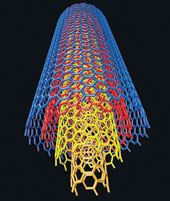 |
 |
| Chandramouli Subramaniam found that carbon nanotubes (top) could emit light in the presence of metallic nanoparticles |
It’s like striking gold at the very first go. When Chandramouli Subramaniam, a PhD student at professor Thalappil Pradeep’s lab at the Indian Institute of Technology (IIT), Madras, chose to work on carbon nanotubes (microscopic tubes of pure carbon whose diameter is 50,000 times less than the width of human hair) in 2002, little did he and his colleagues imagine that they would be breaking new ground soon. That too in a branch of science where research is intense and competition cut throat because of the sheer application potential of the material.
Subramaniam’s idea was to bind carbon nanotubes and nanoparticles (tiny particles less than 100 nanometres in width; 1 nm equals one-billionth of a metre) together and see what the composite can offer. Both these materials have distinct properties and are among those set to replace conventional ones like steel and silicon in the near future.
The task, however, wasn’t easy. Earlier attempts elsewhere to modify properties of carbon nanotubes with nanoparticles had largely failed. Besides, carbon nanotubes were a totally new territory for the team, even though Pradeep’s lab had earned a name for its work on nanoparticles.
Three years later, working late into a December night, Subramaniam — now 26 — could not believe what he saw. The materials scientist spotted a strong but unexpected glow emanating from the composite sample. This glow, or fluorescence, is not normally associated with any of the materials present in the system. Fluorescence occurs when a substance absorbs light of a particular wavelength and emits a different one in response. This property, similar to that in semiconductors like silicon, has tremendous nanoelectronics and biomedical applications.
So where did this glow, clearly visible to the naked eye, come from? Several months of intense research and meticulous experiments later, Subramaniam and his associates reached the conclusion that in the presence of metallic nanoparticles, bundles of carbon nanotubes could end up emitting visible light.
One of the immediate benefits of this is in medicine. For instance, some of the best biomedical tests today, such as magnetic resonance imaging or MRI, cannot be performed in a doctor’s clinic because the equipment is very large and expensive. But if carbon nanotubes can be smuggled inside the body and made to emit light, they can migrate through the walls of cells and report the goings-on inside. Such an apparatus would be so small that it could comfortably sit on a doctor’s table.
Carbon nanotubes — which appear in single-walled and multi-walled varieties — are extraordinarily stable and almost impervious to radiation and chemical destruction. They conduct electricity as well as copper does, heat as well as diamonds do and are 100 times stronger than steel at one-sixth of the latter’s weight. They are tipped to replace the materials used for making automobile bodies. Also, they are so elastic that bullet proof clothes made of them are a near reality. In drug delivery, scientists are trying to use carbon nanotubes to deliver medicines right inside tumour cells.
“After we established that fluorescence occurs in carbon nanotubes, we were thinking about its possible origin and cause,” says Subramaniam. It is already known that bundles of carbon nanotubes do not exhibit fluorescence. This is because although single-walled carbon nanotubes (SWNTs) can be either metallic or semiconducting, the kinds occur mixed together. Naturally, only semiconducting SWNTs emit fluorescence but if they touch a metallic SWNT, their fluorescence is quenched, says Aravind Vijayaraghavan, a scientist specialising in carbon nanotubes at the Institute of Nanotechnology in Research Center Karlsruhe, Germany. Vijayaraghavan feels that this is a very important result as it is the first report of visible fluorescence from a metallic SWNT.
“It seems we have found a novel and simple method to turn carbon nanotubes into semiconducting ones,” observes Pradeep, also the co-author of the paper that appeared in the October 19 issue of Physical Review Letters (PRL).
The discovery has a Calcutta connection too. The theoretical insight into the mechanism came from Jaydeb Chakrabarti, a theoretical physicist at the Bose Institute, Calcutta. “It happened quite accidentally. Pradeep and I have been collaborating since 2000. We were celebrating the successful completion of yet another work published in the PRL journal in a Chennai restaurant together with Subbu (Subramaniam) about two years ago. Suddenly Pradeep disclosed the preliminary results of the carbon nanotubes research,” Chakrabarti told KnowHow.
“They wanted to know whether this was theoretically possible. It occurred to me immediately that the metal nanotubes must have become semiconducting upon the nanoparticle binding. My back-of-envelope calculations showed that a composite may indeed show emission in the visible range if such conversion takes place,” Chakrabarti says.
Subsequently, the scientists embarked on several stringent conductivity measurement experiments which bore out the hunch.
“Carbon nanotubes are better markers because they are more biocompatible and have a longer lifetime than competing markers such as fluorescent proteins,” says Vijayaraghavan.
However, their primary limitation has been the low quantum efficiency, which is a result of metallic SWNTs not emitting any fluorescence and quenching the fluorescence of semiconducting ones. This result will, therefore, increase the efficiency of fluorescent SWNT markers, making them more viable for biomedical imaging applications.
Another use of this material could be as sensors. Gases like hydrogen (which is also stored as energy in fuel cells) are known to reduce fluorescence. Hence, fluorescent SWNTs could be used as indicators of the fuel available in a cell. Besides, the occurrence of visible fluorescence from such structures facilitates their easy, non-intrusive detection and mapping, which is of utmost importance while designing nanoelectronic circuits.
Much of the currently envisaged applications in nanoelectronics are limited by the inability to work exclusively with a single type (either metallic or semiconducting) of nanotubes. The latest work from IIT, Madras, seems to have resolved this problem.










